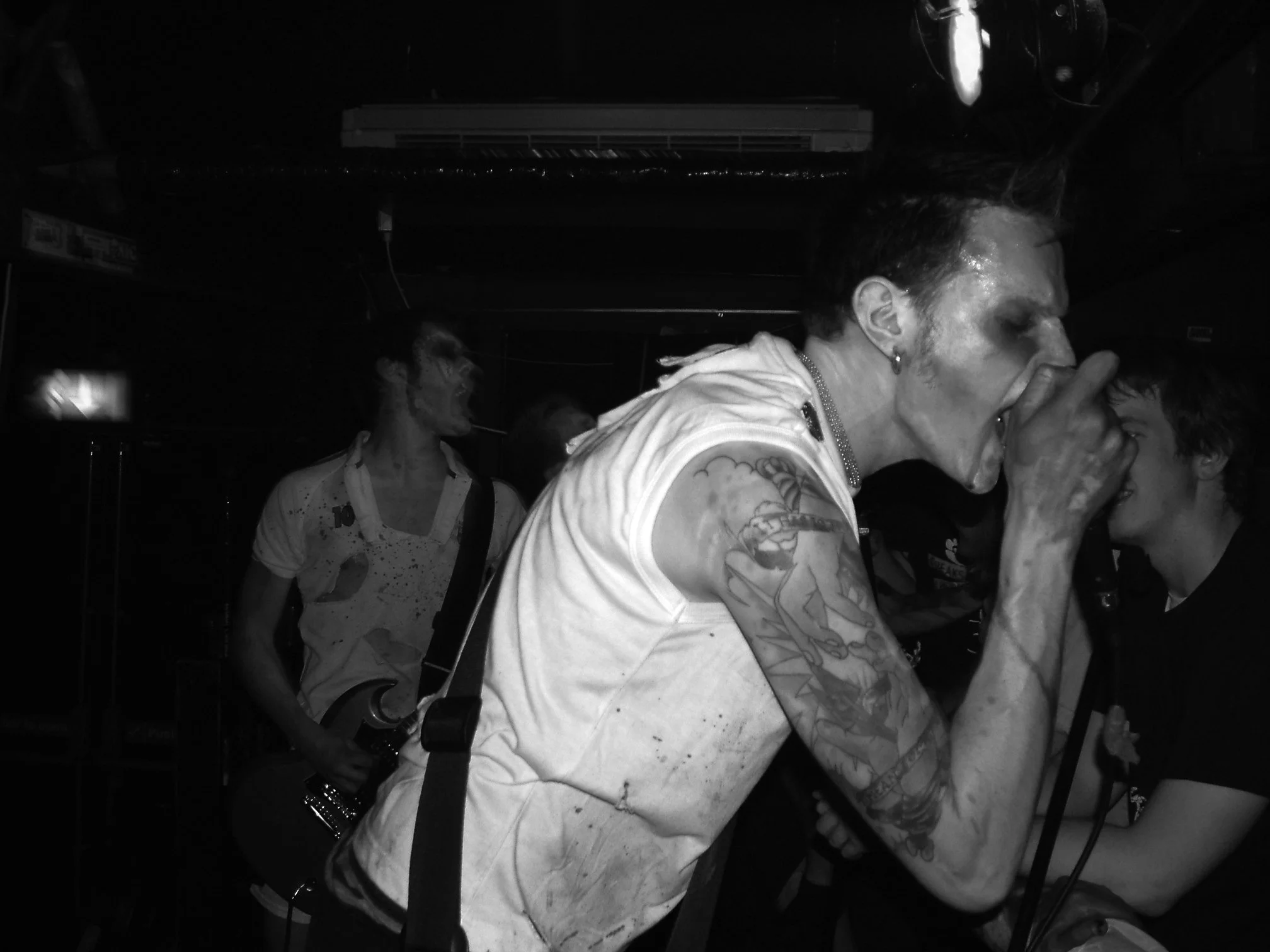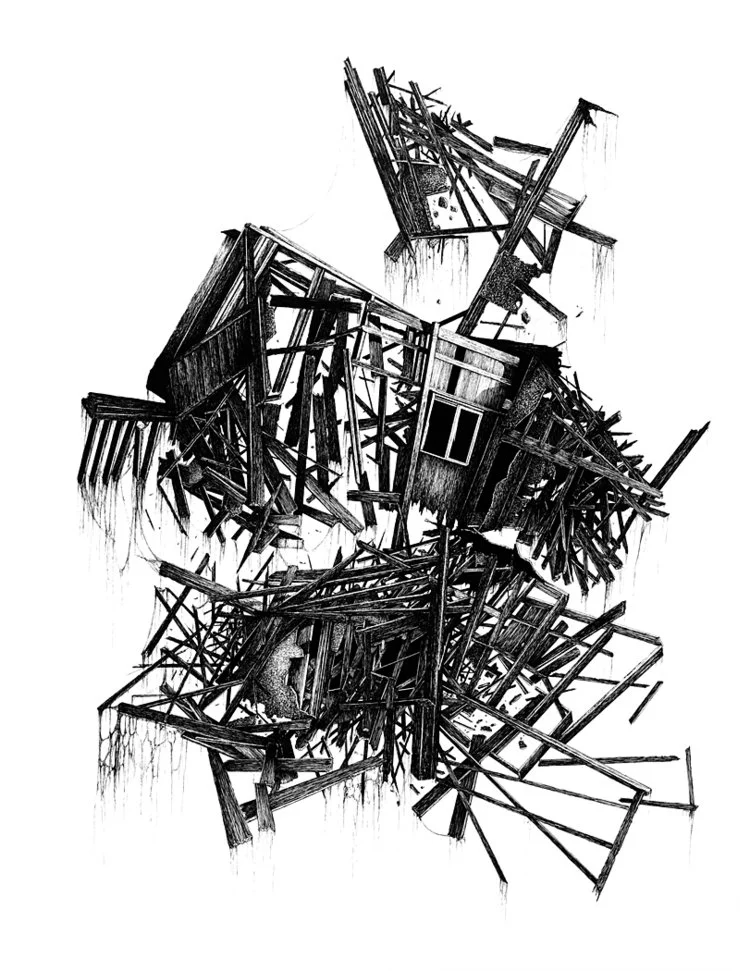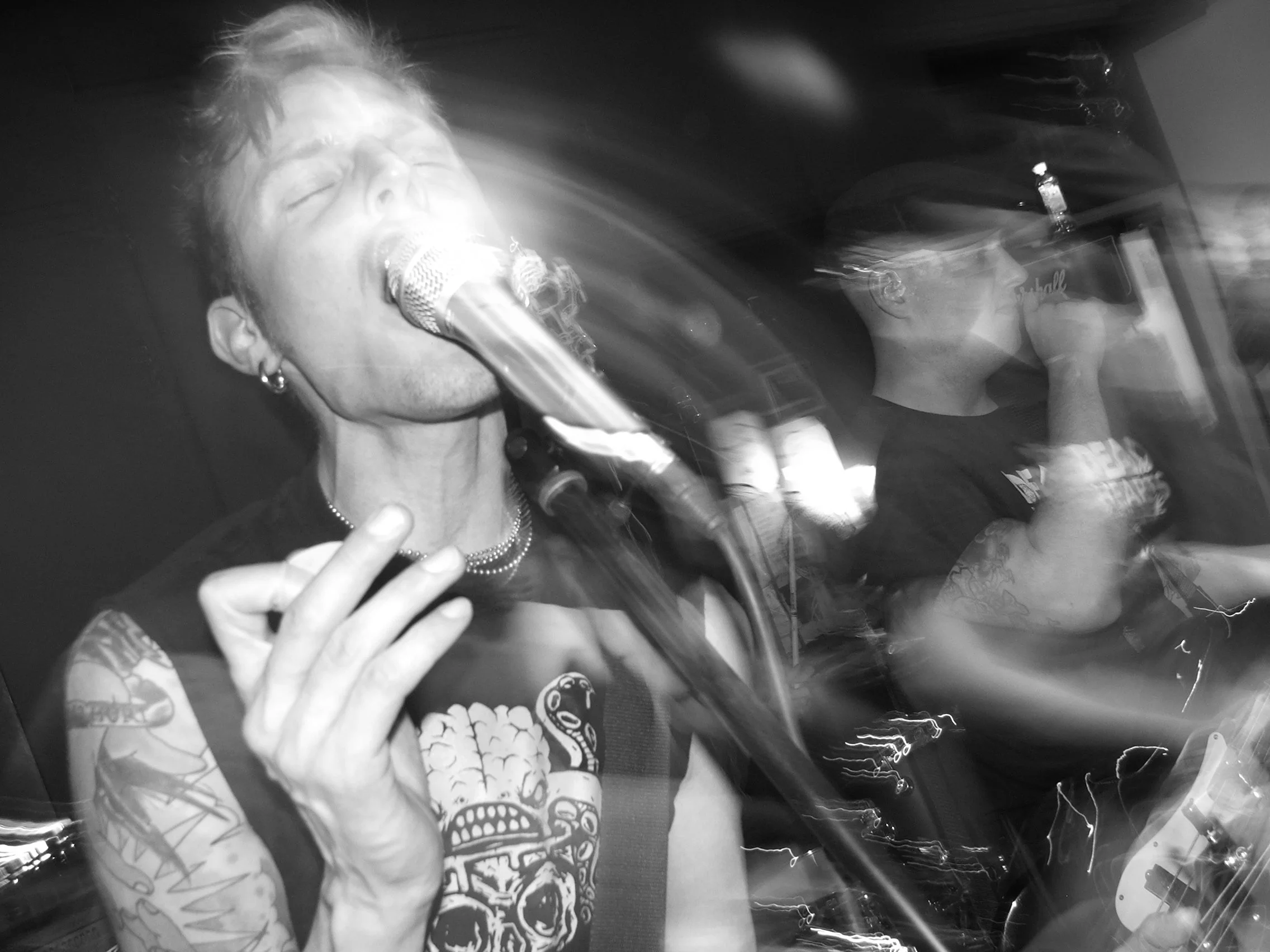How do you even dance to this? Metamodernism and Powerviolence
Introduction
This essay began with a staff workshop at Norwich University of the Arts, where academic and library colleagues from the Animation and Animation & Visual Effects courses gathered to reflect on the art and media that has shaped us. The session was inspired by The Creative Gene, a collection of essays by Hideo Kojima that explores the films, books, and music that informed his creative practice. In the same spirit, we were asked to think about a cultural work that had left a lasting impression on us.
After scribbling down three possibilities, I pulled one at random: Das Oath, the self-titled 2004 album by the hardcore punk band of the same name. What followed was a process of excavating memory, influence, and emotional connection as well as applying a lens of critical research to something that I had experienced in a visceral, emotional way. What was it about this record? Its sound, its energy, it’s provocative awkwardness, that has stayed with me? Why did it matter so much then, and why does it matter still?
Below is the longer-form result of that initial provocation: a critical (and personal) examination of a cultural artefact that was partly responsible for changing the way I think about the creative process.
Das Oath – by Das Oath, 2004. Dim Mak records
I don’t remember the exact moment that I first heard Das Oath, but I remember the time and the feel. The mid 2000s was a time when I was immersed in two things, my studies at art school and the community built around DIY music, particularly punk and hardcore. Both factors in my life were driven by exploration, the desire to try new things, to find aspects of culture and creativity that truly resonated with me. To follow the thread of exploration, mining whatever seam of curiosity took me until I discovered those sublime moments when I would finally find something that just felt right. Something that spoke to me in a secret language that felt like only I and the artist would understand, work that felt like it was made specifically for me. Hearing Das Oath’s self-titled album in 2004 was one of those moments.
The author performing in The Black Veins, photographer unknown, 2005
Das Oath (2004) is in many ways a work of contradictions. The songs seem impenetrable. They are fast, short, sloppily recorded, and drenched in feedback and noise. Yet within them, there are genuine hooks and grooves to be found. The lyrics hold a poetic sensibility of introspection, but are delivered in a sneering scream that makes them close to incomprehensible. The album would be considered to fit within the genre of hardcore punk, yet constantly strives to push against and even reject the limitations of that genre by embracing elements of noise rock and the avant-garde.
The band, a seemingly unlikely transatlantic collaboration between artists based in the Netherlands and the United States were deliberately provocative from the onset, seeking to challenge and question the status quo of the alternative music scene. They engaged in their own mythmaking as seen on the website of Three.One.G, a record label that would release their later material. Here the Das Oath biography is a confusing mix of prose and questionably sourced quotes, dripping in irony and sarcasm, simultaneously self-depreciating, and self-aggrandising. The biography describes the band’s debut EP as a “six minute long wheeze of stolen riffs and jumbled lyrical insensibility” (Anon, Three One G Records, n.d.). While a hyperbolic quote attributed to drummer Marcel Wiebenga sates “Basically, we didn’t even have to try very hard and everyone was copying us... I mean what moron can’t throw together a few notes and call it a song? This crap practically writes itself!” (ibid). The biography goes on to ‘quote’ guitarist Jeroen Vrijhoef stating that his only motivation is royalty checks, and to describe singer Mark McCoy as “a rock star with hang-ups and an over-inflated head that prevents him from walking through doorways.” (ibid). The closing sentence is perhaps the most telling, stating that “DAS OATH may be behave like they live in the stone age, but it’s all a clever act to ensure ‘Hardcore 4 Life’ stays an empty slogan that can conveniently be purchased here on a T shirt from this very site for only $18.99.” (ibid)
Through this deliberately ironic mythmaking, the band paint themselves as the thing that they rail against, the vacuous, self-indulgent rockstar musician, cynically taking advantage of their fans and the DIY music community that supported them for financial gain. Contrast this to the activities of the musicians themselves, of the four members to play on the album, three were operating their own record labels supporting underground music while McCoy has also supplied visual art for innumerable record covers and flyers.
This sense of contradiction and friction within creativity resonated with me in a very immediate way. I was playing in multiple bands at the time and though I loved the energy and the “no gatekeepers” ethic of the DIY punk scene, I was frustrated by the apparent creative conservatism that I encountered. As Moore (2004) puts it “the pursuit of purity has often led hard-core subcultures to enforce a startling homogeneity of dress and sound, which effectively stifles artistic creativity” I distinctly remember one local reviewer dismissing my band with the simple phrase “art school boys. A wall of noise is not punk” (Anon, 2003).
In Das Oath (2004) I found something that resonated with my creative sensibilities. It was urgent, frantic even, with the sense that at any point a song might just collapse in on itself and dissolve into chaos, but somehow never did. That sense of urgency gave the album a lack of preciousness and a sense of being grounded in the present. While other records with slicker production may be considered more accomplished, to me the rawness felt like a way to capture the authentic truth of a moment in time. The music and the presentation of the band was deliberately provocative in its delivery, but always contained enough of a hook to keep people engaged. That was the thing that I think excited me the most, the sense of operating on the very edge of what an audience would accept and finding a way to make it meaningful by using that space of discomfort in a creative way.
The album is clearly informed by the genealogy of hardcore punk and thrash, with musical influences from earlier bands such as Void, SS Decontrol and others, tracing a lineage back to the initial punk explosion of the late 1970s. Specifically, Das Oath could be considered to sit within the subgenre of punk known as powerviolence which is typified by “counts over 400 bpm, with sudden stops and tempo changes, with guitar or bass drones; screamed or growled vocals; and an overarching lo-fi sound quality which is as confrontational as it is polarizing” (Van Loon, 2017, p.193). Unlike many of their contemporaries, Das Oath take this stylistic approach further by incorporating elements of noise rock and experimental music into their sound. Their philosophical approach can be seen in Mark McCoy’s comments on his audio-visual project Hallow:
You have these structures that are intended to convey an idea or purpose... If you compare a house to a song, it has a purpose, it conveys meaning. And to confuse that, to disassemble that, to break that down... That’s the area that I find the interesting part. (McCoy, 2010).
These ideas are reflected in Das Oath (2004) The songs are deconstructed, confused and ambiguous, yet still undeniably recognisable as punk.
NEST from Hallow exhibition, Mark McCoy, 2009
Punk as a cultural phenomenon is often associated with postmodernism and the first wave of punk bore many of the hallmarks of postmodernism: self-reflexive irony, parody, the juxtaposition and repurposing of cultural artefacts to create shock and outrage. This response to a mass-mediated, consumer-driven environment turned signs and spectacles against themselves, as a means of waging war on society. (Moore 2004 p.307). As one of the figureheads of punk ideology “The Sex Pistols mirrored the vacuum effect of consumer capitalism, at once a perfect product, completely meaningless, and a focus for every kind of revolt” (Davies, 1996 p.13). This nihilistic, media entangled response to postmodern society is described by Moore (2004 p.307) as the “culture of deconstruction”. In contrast to this he goes on to describe a second way that punk has responded as the “culture of authenticity”. This response is typified by “a quest for authenticity and independence from the culture industry, thus altogether renouncing the prevailing culture of media, image, and hypercommercialism” (Moore 2004 p.307). This desire for authenticity and meaning is summed up by McCoy (2010) “in Chicago you had this huge pop-punk scene that seemed to be founded on nothing... It was no different to being at a party or a frat house... It didn’t really mean anything and we wanted something that had some substance.”
The renouncing of prevailing media can be seen in punk culture from the early 1980s and persists into present day where it has evolved into a DIY culture and ethic “which allowed those socialized to be consuming spectators of the mass media to involve themselves in cultural production” (Moore 2004 p.313-314). This is perhaps the most important thing that I learned from punk and hardcore, the rejection of gatekeepers, the idea that every member of any given audience has the potential and the power to be more than a consumer, but to play a meaningful part in the creation of the culture that they love.
The author performing in The Black Veins, photographer unknown, 2005
In Das Oath (2004) I see a work that embodies the snarling, irony drenched nihilism of Moore’s “culture of deconstruction” that also embraces the DIY culture, community building and desire for true meaning typified by the “culture of authenticity”. In this work of contradictions Das Oath leaves behind the approach of their forebears, rooted in postmodernism and arrives at a stance of metamodernism, described by Vermeulen and van den Akker (2010) as “characterized by the oscillation between a typically modern commitment and a markedly postmodern detachment.” Das Oath (2004) invites listeners in exactly as it pushes them away, the band proclaim themselves as caricatures of rockstar excess, while constantly supporting the underground music scene. Everything about the band oscillates between contradictory elements and, perhaps there is some truth to each of them.
“Metamodernism moves for the sake of moving, attempts in spite of its inevitable failure; it seeks forever for a truth that it never expects to find.” (Vermeulen and van den Akker, 2010 p.5).
Creatively, I think that’s a good place to be.
Bibliography
Albini, S. (1984) ‘Tired of Ugly, Fat?’, Matter – A Music Magazine, 10
Anon, Three One G Records (n.d.) ‘Das Oath Bio’, Three One G Records. Available at: https://threeoneg.com/artists/das-oath (Accessed 19 Jul. 2024).
Anon, (2022) ‘Charles Bronson “Youth Attack” 25th Anniversary Edition’, Youth Attack. Available at: https://www.ihateyouthattack.com/category/releases/ (Accessed 31 Jul. 2024)
Cussen, J. (2022). What is Metamodernism? The Living Philosophy. Available at: https://www.thelivingphilosophy.com/what-is-metamodernism/. (Accessed 19 Jul. 2024).
Cussen, J. (2022). Modernism vs. Postmodernism. The Living Philosophy. Available at: https://www.thelivingphilosophy.com/modernism-vs-postmodernism/. (Accessed 19 Jul. 2024).
Das Oath, (2004) ‘Das Oath’, Rotterdam, Dim Mak Records
Davies, J. (1996). ‘The Future of ‘No Future’: Punk Rock and Postmodern Theory’, The Journal of Popular Culture, 29(4), pp.3–25.
James, D. and Seshagiri, U. (2014) ‘Metamodernism: Narratives of Continuity and Revolution’, PMLA, 129(1), pp. 87-100.
McCoy, M. (2009). ‘Hallow Soundtrack’, [vinyl] Amherst, Youth Attack Records
McCoy, M (2009). ‘Hallow’ [ink on paper] Hope Gallery, Los Angeles. Exhibition
Moore, R. (2004) ‘Postmodernism and Punk Subculture: Cultures of Authenticity and Deconstruction’, The Communication Review, 7(3), pp. 305-327.
Sawa, M. (2020). ‘‘We need to rediscover the living body’ : Gabriel Josipovici’s metamodern project in Goldberg: Variations’, Brno studies in English, 46(2), pp.261–279.
The Lo Fi Horror Guy (2021). Mark McCoy (Charles Bronson, Das Oath & Youth Attack Records) Interview -Growing On You Live # 118. Available at: https://www.youtube.com/watch?v=td36dERQPx8&t=1s&ab_channel=TheLoFiHorrorGuy (Accessed 31 Jul. 2024).
Van Loon, B. (2017) ‘Powerviolence, or how to play punk with a ‘hammer’’ in Dines, M., Gordon, A. and Guerra, P. eds., The Punk Reader. Research transmissions from the local and the global. Porto, Portugal: Universidade do Porto. Faculdade de Letras, pp.193-207
Vermeulen, T. and van den Akker, R. (2010) ‘Notes on metamodernism’, Journal of Aesthetics & Culture, 2(1), pp. 1-14.
ZipitZipper (2010). MARK McCOY ON DOPE SICK RADIO PART1. Available at: https://youtu.be/q-saXZTwbMw?si=2DkwTmC7ss3ZZglc (Accessed 31 Jul. 2024).
ZipitZipper (2010). MARK McCOY ON DOPE SICK RADIO PART2. Available at: https://youtu.be/AtmAmED0whI?si=4FyCmKSs2riEgb58 [Accessed 31 Jul. 2024].


